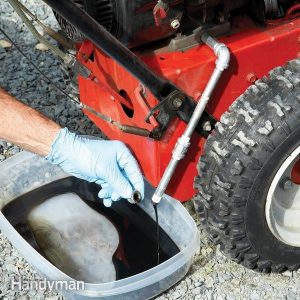A snowblower needs oil for lubrication just like any other piece of machinery. Typically, you should change the oil in a snow blower after the first few hours of use to remove the initial oil and consequently after every 50 hours of use.
Even if you do not use it for the whole 50 hours, it is advisable to change the oil if the snow blower has been in disuse for a while.
After the overwhelming snow experienced this winter, it is essential if not critical to make sure that your snowblower is in tip-top shape for next winter.
As such it is essential for you to work on your snow blower sooner rather than later to avoid being disappointed. These are the guidelines to follow when changing the oil during snowblower maintenance;

1. Choose the right oil type
The best oil type for a snowblower depends on your climate. Most snow blower manuals suggest using 5W30 oil for an area with temperatures above zero degrees Fahrenheit and DW30 for areas with temperatures above -40 degrees Fahrenheit.
You also need to determine whether to use synthetic or natural oil depending on the temperature variations in your region. Synthetic oil is better in this case. The oil used is usually motor oil.
2. Get the right tools
To avoid running to the store when it’s time to change the oil in your snowblower, make sure the right tools to handle the job. Your tool kit should have the following tools; a galvanized 90-degree elbow, a galvanized cap, galvanized nipples, a pipe joint tape and pipe wrenches.
3. Prevent an oily mess
Device an oil drain that will steer oil away from the floor into a drain extension and ultimately an oil collection bucket to avoid having an oily mess in your garage.
This does not have to be a fancy contraption to attach to the snow blowers inbuilt oil drain that is usually too short. You can make one with a flexible PVC pipe.
4. Inspect your engine
Inspect your Spark plug and make sure it is not cracked or filled with dirt. Clean it if the grime is minimal and replace it if the dirt is too much. Make sure that the plugs you buy are suited for a snow blower.
Make sure you inspect the gearbox if you have a 2-phase snow blower to see if it is properly oiled.
5. Siphon gas out
Always siphon the gas out of your snow blower before you store it for a prolonged period. The reason being the ethanol in the gas will evaporate and leave behind rubbery gunk.
This will, in turn, mess up the carburetor and prevent your snow blower from starting up when it is time to use it. Also, clean and replace your fuel filter before you refill it.
6. Go through your checklist
Finally, inspect the following before using the snow blower; bolts, belts and moving parts, scraper bar, rubber paddles and the rubber around the snow blower auger. Replace the rubber if it is worn out and tighten any loose bolts.
Replacing oil in a snowblower is essential for it to work for prolonged periods. The following tips will help you to not only replace the oil but also prepare your mower for an oil change.
